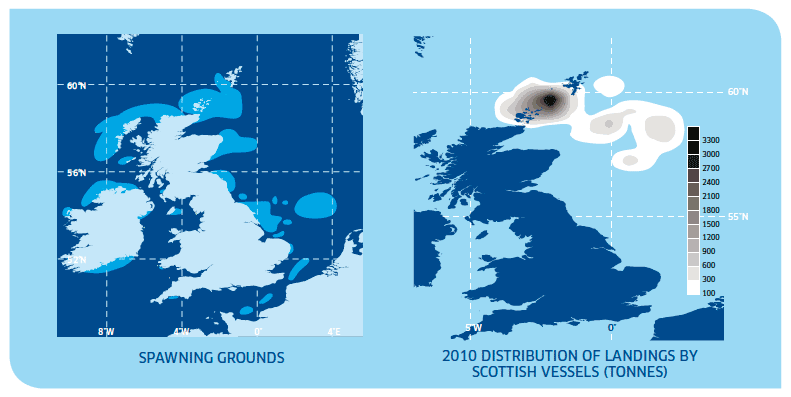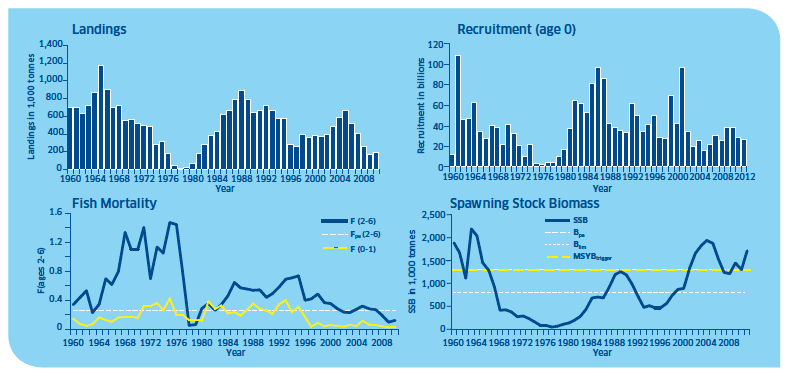Fish and Shellfish Stocks 2012
Fish and Shellfish Stocks 2012. State of Scottish fish stocks, TACs and biology of the stocks for 2012.
HERRING STOCKS – NORTH SEA
Herring ( Clupea harengus) is the second most important species landed by the Scottish pelagic fleet. It is mainly caught for human consumption by vessels towing large pelagic mid-water trawls, with very little by-catch of other fish.
2012 position : UK share 57,836 tonnes
Last Year : 29,832 tonnes
Landed into Scotland in 2010 : 27,566 tonnes
Value for 2010 : £7.95 million
Biology
During daytime, herring shoals remain close to the sea bottom or in deep water. At dusk they move towards the surface and disperse over a wide area. Although most fish species have a single spawning season, herring is one of the exceptions. The sub-populations of North Sea herring spawn at different times and localised groups of herring can be found spawning in almost any month. The North Sea stock is dominated by autumn spawners. Currently, three major populations can be identified by differences in spawning time and area. These are: Buchan / Shetland herring, spawning off the Scottish and Shetland coasts during August and September; Banks or Dogger herring, spawning in the Central North Sea and off the English coast from August until October; and the Southern Bight or Downs herring, spawning in the English Channel from November until January. For most of the year the different populations mix, but during the spawning season they migrate to their separate areas.
Some herring mature and spawn at two years of age, but most are three or four before they spawn. The number of eggs produced by an average-sized female varies between populations. A 28cm female from the Downs stock produces around 42,000 eggs per year whereas a similarly sized female from the Buchan stock can produce 67,000 eggs. Herring are demersal spawners, depositing their sticky eggs on coarse sand, gravel, small stones and rock. Shoals of herring gather on the spawning grounds and spawn more or less simultaneously. Females release eggs in a single batch and the resulting egg carpet may be several layers thick and cover a considerable area. The eggs take about three weeks to hatch depending on the sea temperature.
Many autumn hatched larvae spend their first winter drifting towards nursery areas on the eastern side of the North Sea, around the Moray Firth, the Firth of Forth and in the western North Sea. Their drift rate is variable and in some years many do not reach the nursery areas. As they grow, the juvenile herring move offshore, eventually joining the adult populations in the feeding and spawning migrations in the western areas of the North Sea. Some of the herring in the North Sea nurseries originate from the spawning grounds on the north and west coasts of Scotland.

ICES ADVICE ON MANAGEMENT
Information Source: ICES advice 2011 ( http://www.ices.dk/committe/acom/comwork/report/2011/2011/her-47d3.pdf). Quoted text in italics.

MSY and precautionary approach reference points
| Type |
Value |
||
|---|---|---|---|
| Management Plan |
F MP |
>1.5 million tonnes |
F 0-1 = 0.05 |
| <1.5 & >0.8 million tonnes |
F 0-1 = 0.05 |
||
| <0.8 million tonnes |
F 0-1 = 0.04 |
||
| MSY Approach |
MSY B trigger |
Not defined |
|
| F msy |
0.25 |
||
| Precautionary Approach |
B lim |
800,000 t |
|
| B pa |
1.3 million t |
||
| F lim |
Not defined |
||
| F pa |
F 0-1 = 0.12 |
||
State of stock and advice
- Fishing mortality in 2010 was estimated at 0.025 for juvenile fish (aged 0-1 year) and 0.118 for adult fish (aged 2-6 year): this means that 2.5%, by number, of juvenile (aged 0-1 year) fish and approximately 11%, by number, of adult (aged 2-6 year) fish were caught. This stock is, therefore, classified as being harvested sustainably.
- Spawning stock biomass was predicted to be around 1.7 million tonnes in 2011, which is above B pa and classified as being at full reproductive capacity.
- Fishing mortality and spawning stock biomass are below and above, respectively, the precautionary limits. Fishing mortality is below the level which is consistent with achieving maximum sustainable yield ( F 2010> F MSY ).
- The advice, in accordance with the multi-annual management plan, recommends that landings in 2012 should be 230,000 tonnes for the main North Sea fleet and 17,900 tonnes for the small mesh industrial fleet.
In early 2011 the EU-Norway management plan was reassessed by ICES, and was found to operate well in relation to the objectives of consistency with the precautionary approach and a rational exploitation pattern. However, in late 2011, a joint EU-Norway request led to an evaluation of the harvest control rule ( HCR) within the management plan to determine if it is compatible with the precautionary approach if the 15% TAC constraint rule is not applied. Several options were tested, based on the assumption that the current low productivity regime for North Sea herring (observed since 2002) will continue. All options were found to be compatible. ICES concluded that the current HCR, i.e., without a 15% TAC constraint, is compatible with the precautionary approach as the risk of SSB falling below B lim is low.
Although the estimates for the 2008 and 2009 year classes are above the geometric mean of the time-series, and the year classes of 2007 and 2008 have been revised upwards, ICES still considers the stock to be in a low productivity phase. The management plan has proved to be an effective tool for maintaining sustainable exploitation and conserving the North Sea herring stock in this lower productivity regime.
Management outcomes for 2012
At the December 2011 meeting in Brussels, the Council of Ministers decided that the international Total Allowable Catch for North Sea herring (north of 53° 30' N) in 2012 should be 405,000 tonnes. The UK quota has been set at 57,836 tonnes.
Evaluations and discussions prior to the Council resulted in a potential modification to the herring management plan which may be considered in the future. The plan, which provided a less stringent catch restraint rule, was applied giving rise to a substantial increase in TAC but still keeping the stock within the acceptable boundaries.
Contact
There is a problem
Thanks for your feedback